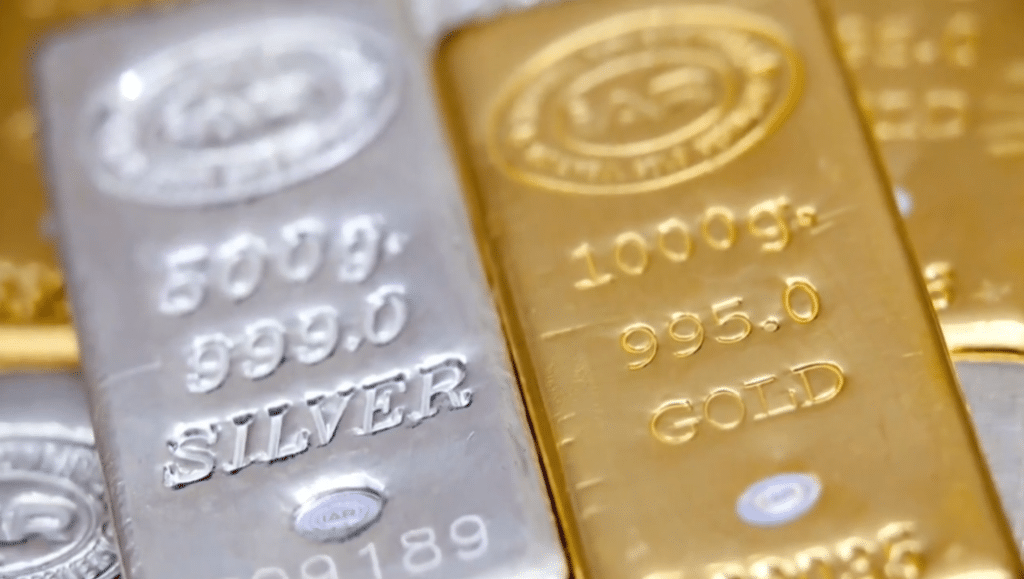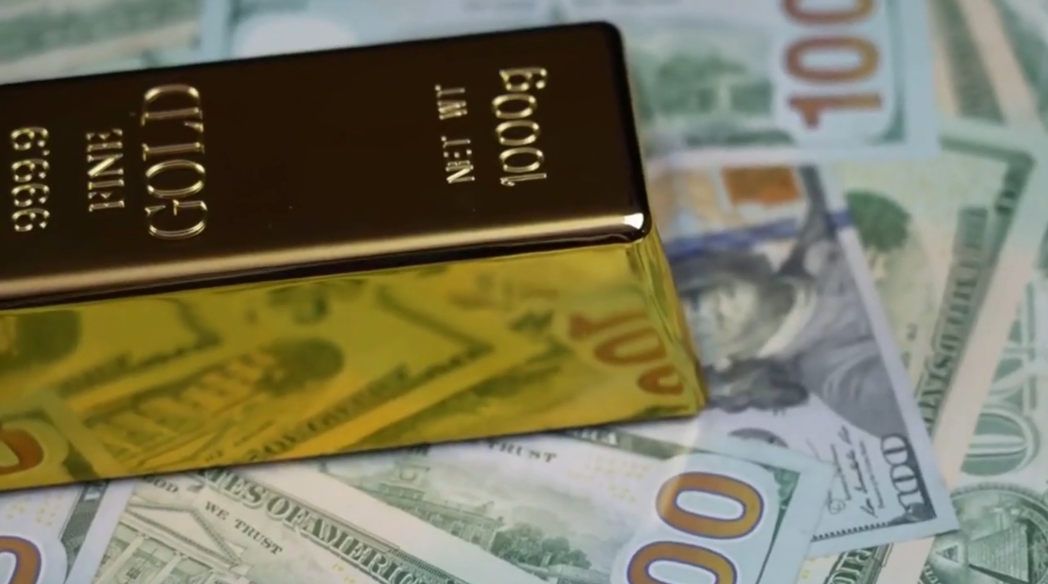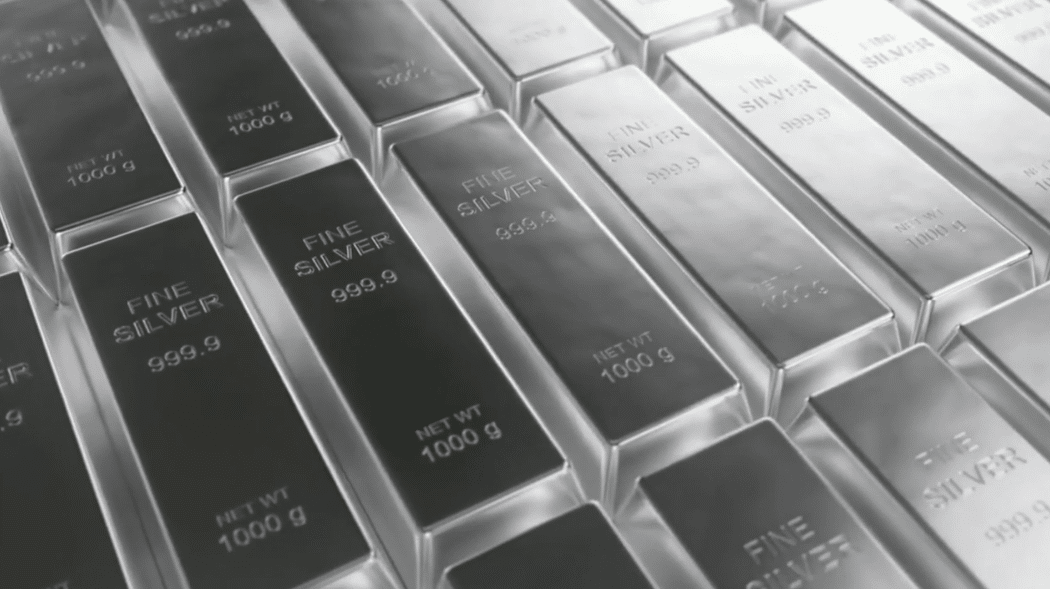Gold Vs Silver

You’re eyeing gold and silver for your portfolio, aren’t you? It’s a wise consideration, but do you know the key differences?
Volatility, long-term returns, and economic sensitivity aren’t the same for these precious metals. Let’s delve deep and understand what sets gold and silver apart. To make the best investment choice, we need to discuss:
- Gold vs. silver: Ways to own it
- Gold vs. silver: Long-term returns
- Gold vs. silver: Inflation hedge
- Gold vs. silver: Speculative uses
- Gold vs. silver: Volatility
- Gold vs. Silver: The 5 Differences That Matter Most to Investors
- Gold vs Silver – Which Investment is Right for you?
This guide isn’t just facts, it’s your tool for strategic investing. Ready? Let’s navigate the glittering world of gold and silver together.
Gold vs. Silver: Ways to Own It
When you decide to gear up for investing, you can’t overlook the undeniable value that gold has demonstrated throughout history. This precious metal has served as a form of money for over 5,000 years, outlasting countless currencies and financial crises. It’s not just about its glittering appeal; gold’s value is deeply rooted in its historical significance and enduring resilience.
Unlike stocks and bonds, gold isn’t positively correlated with other assets. This characteristic makes it an excellent diversification tool for your portfolio. When other assets tumble, gold often holds steady or even appreciates, providing a safety net during market downturns.
The value of gold isn’t limited to its monetary role. It’s a tangible asset, impervious to fire, water, and time. It doesn’t require feeding or maintenance, like livestock or property would. This makes gold a hassle-free investment that you can store safely and securely, free from the worries of depreciation due to physical wear and tear.
Furthermore, gold has no counterparty risk. It doesn’t rely on someone else’s promise or ability to pay. What you see is what you get. Its value doesn’t hinge on a company’s performance, a government’s stability, or the whims of the global economy.
In a world of volatile markets and uncertain economic outlooks, gold stands firm. Its undeniable value has been proven time and again throughout history. So, when you’re planning your investment strategy, don’t forget to consider the golden opportunity that gold presents for portfolio diversification, risk management, and long-term value preservation.
Gold vs. Silver: Long-Term Returns
In evaluating long-term returns, you’ll find that both gold and silver have shown growth over the years, but their rates of return vary significantly. As Robert R. Johnson, a professor of finance, indicates, gold has consistently outperformed silver since 1925.
Gold’s price per ounce has risen from $20.63 in 1925 to $1893.66 in 2020, which equates to a compounded annual return of 4.87%. Silver, on the other hand, has increased from $0.68 per ounce in 1925 to $17.14 in 2020. This represents a compounded annual return of 3.46%.
While these returns may not seem substantial, it’s crucial to consider them in the context of long-term investment strategies.
However, inflation can significantly erode these returns. Over the same 95-year period, inflation averaged 2.9% per year. This dramatically reduces the growth in purchasing power you’d receive from investing in either gold or silver.
You should also consider the inherent volatility of these precious metals. Silver tends to be more volatile than gold, which can lead to higher potential gains but also greater risks. Gold, with its relative stability, offers a safer, albeit potentially lower-return, investment.
Gold vs. Silver: Inflation Hedge
You might consider gold and silver as potential hedges against inflation, but it’s important to understand how each performs under inflationary conditions. High inflation can create market uncertainties, often leading investors to move their assets into gold to protect their wealth. Yet, it’s essential to know that the correlation between gold and inflation can sometimes break in the short term.
Let’s delve into the specifics of how gold and silver function as inflation hedges:
- Gold: This precious metal is often seen as a safe haven during turbulent market conditions. The rising inflation might cause more significant investments to flow into gold, thereby preserving the value of money. However, when interest rates react to higher inflation, investments might be diverted to the debt market, breaking the short-term correlation between gold and inflation.
- Silver: The correlation between silver and inflation is also high, but not as rock-solid as with gold. Silver’s industrial demand tends to wane during high inflation, creating a balancing act with the robust demand from the investment segment. Conversely, when inflation is low, the situation reverses, with industrial demand for silver increasing.
- Investment Considerations: When deciding between gold and silver as an inflation hedge, consider your risk tolerance, investment timeframe, and overall portfolio composition. Both metals can serve as effective hedges, but their performance can vary based on market conditions and economic factors.
A tax-advantaged means of owning physical gold and silver without the need or liability of storing the precious metal in your residence is a gold IRA. Gold IRA companies provide investors with competitive pricing, a reasonable buyback guarantee, lifetime customer support, and secure storage of their gold and silver.
Gold vs. Silver: Speculative Uses
Building on gold and silver’s potential as inflation hedges, let’s now explore their speculative uses, where your investment strategy can significantly affect their performance.
Gold is primarily used as a store of value with limited industrial applications. Nearly 90% of gold’s demand comes from investments and related sectors. As an investor, your evaluation of safety and return expectations from other asset classes like stocks and bonds can drive its price. Given its relatively high price per ounce, gold offers an easier way to store value compared to silver.
On the other hand, the demand for silver is fueled more by its industrial applications, such as electronics and solar cells. It thrives during periods of economic stability and growth. As silver is more accessible and perceived to offer higher value, it mainly attracts smaller and retail investors. Nevertheless, its lower price relative to gold also means that storing an equivalent dollar value requires more physical space.
In speculative terms, silver’s industrial base can lead to higher volatility, which can present both challenges and opportunities. Its price can fluctuate significantly based on the industrial demand and the state of the global economy. Conversely, gold’s price stability can offer a safe haven during economic uncertainties, but this also means less opportunity for high short-term gains.


Gold vs. Silver: Volatility
When it comes to volatility, don’t underestimate how much silver’s prices can swing compared to gold’s. In shorter periods, silver can show remarkable volatility. This is due to its relatively low liquidity, especially in the financial market. These price fluctuations can make silver a riskier bet than gold.
Now, let’s delve into some reasons why silver’s volatility exceeds that of gold:
- Economic Sensitivity:Silver is highly sensitive to changes in the economy because it’s heavily used in industry and high-tech products. When economies surge, demand for silver grows, causing price fluctuations. Gold, on the other hand, has limited industrial uses, making it less affected by economic ups and downs.
- Liquidity:Silver’s lower liquidity in comparison to gold contributes to its volatility. A lower liquidity means that price changes can have a larger impact on your investment. This makes managing portfolio risk a bit more challenging with silver.
- Market Perception:The perception of silver as a riskier investment than gold can lead to greater price swings. When investors get nervous, they may sell off their silver, causing prices to drop sharply. In contrast, gold is often seen as a safe haven during market turmoil, which helps to stabilize its price.
Working with a Suitable and Trusted Gold Investment Company
When starting on the path of gold investing, working with a credible and trustworthy precious metals vendor is key. Finding an established gold investment company that understands the many vacillations of the gold markets and the numerous variables affecting its price will save much time and hassle. Working with a reputable company with institutional knowledge can assist you with logical price entry points, positioning, and dollar-cost-averaging so you can maximize your investment capital.
Gold IRAs provide additional advantages to merely buying gold from a local dealer. Choosing the right gold IRA company will depend on one’s unique investing needs. Depending on whether you are a high-net investor looking for the most competitive prices or require a lower investment minimum and affordable entry to the gold market, we have researched and reviewed our best 4 gold IRA and precious metal investment companies that meet those individual needs. In addition to a gold IRA, owning the physical gold in your place of residence is also an option. We have provided links to these companies at the bottom of this article for your convenience.
To learn more about the advantages of tax-deferred gold IRAs right now, click the banner below to access and download Augusta Precious Metals’ gold IRA checklist to make sure you are aware of all aspects of the gold IRA process:
Gold vs. Silver: The 5 Differences That Matter Most to Investors
When comparing gold and silver, five critical distinctions significantly affect your investment decisions.
You’ll find that silver’s price is more volatile, it’s more affordable, and it requires much more storage space than gold.
Moreover, silver has a higher industrial use, and while silver stockpiles are dwindling, gold’s are on the rise.
The Silver Price is More Volatile
Although you might find silver’s lower price point enticing, it’s important to understand that its value can be significantly more volatile than gold’s. This is due to the smaller market size of silver, making it more susceptible to sharp price swings.
- Market Size:The annual supply of silver dwarfs that of gold, but its lower price means the total value is much smaller. This smaller market can be more easily swayed by investor actions, leading to higher volatility.
- Investor Impact:Silver’s volatility can be a double-edged sword. It can provide larger returns in bull markets, but also steeper falls in bear markets.
- Strategic Approach:Be prepared for silver’s volatility. Embrace it as an opportunity for higher returns, but be ready to act swiftly when market tides turn.
Silver is More Affordable
So, given silver’s high volatility, why might you still consider investing in it?
One key reason is its affordability. Often termed the ‘poor man’s gold’, silver provides many of the same benefits as gold, but at a fraction of the cost. This makes it an accessible entry point for average investors, unlike gold which can put a heavier dent in your wallet. Even if you opt for smaller denominations of gold, premiums spike for products less than an ounce.
With silver, you can hold a tangible asset, devoid of counterparty risk, and never defaulted on. Also, the practicality of silver extends beyond investment, proving useful for small, everyday purchases or gifts.
Thus, despite its price swings, silver’s affordability presents a compelling case for investment.
Silver Requires Much More Storage Space
You’ll need to consider that storing silver requires significantly more space than gold due to its lower value per ounce. This increased space requirement comes with additional storage costs, making silver a more cumbersome investment choice.
To illustrate:
- At current prices, a $50,000 investment in silver weighs about 189 pounds, while the same value in gold weighs just 2.6 pounds.
- The same dollar value of silver takes up to 128 times more space than gold, affecting storage possibilities.
- Silver tarnishes over time, necessitating a dry, element-free storage environment, unlike gold.
Therefore, while silver’s affordability is attractive, the logistics of storage can add an extra layer of complexity to your investment strategy.
Silver Has Higher Industrial Use
While the storage of silver may pose more challenges due to its volume, you can’t ignore its higher industrial use compared to gold. With 56% of silver supply being used in industry, it’s a metal you interact with daily, whether you realize it or not. From electronic devices to medical applications, and solar panels to batteries, silver’s properties make it indispensable.
However, this high demand is susceptible to economic fluctuations. In a robust economy, industrial demand for silver soars, but in a recession, it weakens. Furthermore, unlike gold, a significant portion of silver is lost annually as it’s not economically viable to recover small quantities from discarded products.
This unique aspect of silver needs to be factored into your investment decisions.
Silver Stockpiles are Falling, Gold’s are Rising
You might find it surprising that silver stockpiles are dwindling, while gold reserves continue to rise, making a significant impact on their respective markets.
- Silver Stockpiles: Governments and institutions used to hold large inventories of silver. Now, only the US, India, and Mexico maintain considerable stockpiles. The decrease in silver reserves makes the market sensitive to sudden rises in demand, potentially causing price spikes.
- Gold Reserves:In contrast, central banks are buying gold every year, amassing over 1.09 billion ounces in reserves. This steady demand contributes to gold’s market stability.
- Future Implications:If governments start buying silver, it could drastically impact the market. Meanwhile, the increasing gold reserves contribute to its ongoing demand and price stability. This divergence could be crucial to your investment strategies.
Gold vs Silver – Which Investment is Right for you?
When considering gold and silver as potential investments, it’s crucial to examine several factors.
Firstly, consider your long-term financial goals – gold’s stability might suit those seeking a safer, steady growth, while silver’s volatility could attract those willing to assume higher risk for potentially larger returns.
Additionally, being aware of the timing of gold and silver prices, as well as how these precious metals can add value to your overall investment portfolio, will aid in making an informed decision.
Gold Investing for the Long Term
Consider your long-term financial goals and risk tolerance before deciding whether to invest in gold or silver. Both have their benefits and challenges. For instance:
- Gold has shown steady growth, rising over 5,000% since the early 1970s. It’s considered a powerful portfolio diversifier and a reliable hedge during economic downturns. However, its high price might be a barrier for some investors.
- Silver, while more volatile and sensitive to economic changes, is more affordable and accessible. This could provide greater potential gains (and losses).
- Both can be owned through various methods including bullion, futures, ETFs, and mining stocks.
The choice between gold and silver depends largely on your financial situation, risk tolerance, and investment goals. Make sure to do thorough research before making a decision.
Timing of Gold and Silver Prices
Understanding the timing of gold and silver prices is crucial in determining which investment is right for you.
Silver’s volatility, largely due to its industrial uses, means its price can swing by 20% or more rapidly, offering potential for significant short-term gains or losses.
Gold, less influenced by industrial applications, usually has more stable prices, providing steady investment growth.
Recognize that the market prices for these precious metals can shift quickly, demanding strategic timing when buying or selling.
It’s essential to grasp why perceptions of value for these commodities change to maximize returns on your investment.
Your choice between gold and silver will hinge on your appetite for risk, your understanding of market trends, and your investment timeline.
Gold and Silver Add Value to Investments
You’ll need to carefully assess your individual financial goals and risk tolerance to determine whether investing in gold or silver can add more value to your portfolio. Consider these three factors:
- Tax Implications: In the UK, gold investments are VAT-free, while silver incurs a 20% VAT. This means silver’s market price must rise at least 20% to break even.
- Volatility: Silver’s price fluctuates more, potentially offering higher returns. However, it also carries more risk.
- Intrinsic Value: Gold holds more value due to its scarcity, rendering it a more stable investment.
Understanding these elements can help you make an informed decision.
Ultimately, whether gold or silver is the right investment for you depends on your financial circumstances and investment goals.
Conclusion
In conclusion, gold and silver both present unique investment opportunities.
Gold offers stability and a hedge against inflation, while silver’s volatility may lead to higher returns.
Ultimately, your choice hinges on your risk tolerance, budget, and diversification strategy.
Remember, smart investing isn’t about picking the ‘best’ asset, but about creating a balanced portfolio that aligns with your long-term financial goals. So, weigh your options carefully before diving into the world of precious metals.
If you have 100k in savings to protect and want to take advantage of the best gold prices and lifetime customer support, attend a free gold and silver educational web conference hosted by Augusta Precious Metals. Secure your place today by clicking the banner below.
If you have 100k in savings to protect, attend a gold investment educational webinar hosted by Augusta Precious Metals. Click the button below:
Obtain a gold IRA guide and talk to a broker




Gold IRA FAQs

Adam ONeill
Author, lifelong investor, and creator of PreciousMetalsInvestmentPortfolio.com



